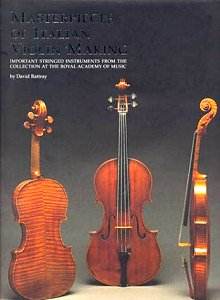It’s over a decade since the first edition of David
Rattray’s ‘Masterpieces of Italian Violin Making’ appeared and a great
deal has happened over that time to make a second edition worthwhile
and valuable. The text has been updated and there are an additional
fifteen instruments documented as well as two sumptuous full colour
spreads. Advances in dendrochronological readings mean an extensive
dating programme has been undertaken and the results – tabulated as
an appendix - list attributed date, maker’s date and the youngest ring
date. Tree ring dating is a contentious issue – note the still dangerous
area of Oxford’s Messiah Strad – but the widest disparity between dates
among the measured instruments here is forty-one years.
All these instruments form part of the collection of
the Royal Academy of Music. A private collection, many of the instruments
are on loan to players. Now that the RAM has opened its York Gate museum
far more people will be able to see and appreciate the richness of the
collection (which includes twelve Strads) and to reflect upon the successive
bequests from named individuals that has made the building up of the
collection possible – there are some two hundred and fifty stringed
instruments in total, of which forty-one are illustrated here, an increase
over the twenty-five in the first edition. Almost all are in a highly
pure state of preservation – the 1695 Rugeri has exceptionally been
cut down and there is a composite 1720 Strad; otherwise they are intact.
As a result of the initiatives of the RAM instrument loans have increased
in the interim and maintenance has risen commensurately as well.
Violin books – iconographic or illustrative – are notoriously
expensive. The rarity of the instruments described, their inaccessibility,
and the difficulty and relative complexity of photographing and measuring
them affords its own problems. The expense of colour plates is not negligible
and suitable paper must be used to optimise the clarity and depth of
colour of the photograph – this is one area in which a publisher can
ill afford to cut corners. These issues collectively mean that such
studies are relatively rare and generally priced beyond the means of
most enthusiasts or interested readers.
A study such as this, based on an individual collection,
such as, for example, Boyden’s Ashmolean Hill Collection stands
or falls by the accuracy of its text and the clarity, detail and beauty
of its photography. In the first edition of this work, slightly smaller
in size (the second measures 13"x9¾"), 72pp as against the
weighty 192pp of the second edition, the study illustrated instruments
with black and white photographs as well as colour (the second edition
is all colour). In respect both of text and illustration this second
edition is exceptionally, marvellously successful. Rattray has had the
assistance of a distinguished collection of experts in the field and
the result is an authoritative and aesthetic triumph.
The format is broadly similar; text on the left hand
page with principal dimensions tabulated and a small photograph of the
scroll of the instrument. On the facing page are two photographs of
the instrument, front and back. Overleaf, on a double spread, are full-page
enlargements of the front and back – duplication of course but necessarily
so as to afford the opportunity for comparison and closer study. There
are particularly stunning spreads of scrolls; that of the 1718 Maurin
Strad, glorious in full size is noteworthy but the 75% shots of the
Guarneri cello of 1692 are equally remarkable. The photography, it has
to be reiterated, is exceptional and those who have seen Sotheby’s Sales
catalogues of Stringed Instruments will recognise the style. The text
is clear, analytical, accurate and adds practised judgement in matters
of the stylistic change of instrument makers. Fruitfully the text also
sometimes appends the names of players who have – or have had – use
of the instruments and a discography of instruments is also added -
so you can find out with what instrument Ralph Holmes recorded Delius
(it was the 1734 Habeneck Strad) or Zara Nelsova recorded Bloch
(the Marquis de Corberon, a Strad cello of 1726). And many more
contemporary players too, such as Clio Gould, Roger Bigley, Kenneth
Sillito, Paul Silverthorne and so on.
We can also read in the text of the many distinguished
players who have played these instruments at some time during the course
of their careers. The names of violinists Frederick Grinke, David Martin,
Joan Field and Winifred Small appear, as do those of violists Bernard
Shore, Watson Forbes, Yuri Bashmet and a number of other fine players.
There are a few trifling textual errors. Zara Nelsova
recorded for Vanguard not Vauquard, and whilst it’s true that she took
American citizenship some time in the 1950s I still think calling her
an American cellist is like calling T.S. Eliot an English poet. Otherwise
I have nothing but the profoundest admiration for a work that explores
with such clarity and elegance the R.A.M. collection, that details the
instruments’ individual histories with such precision, that reflects
upon construction techniques with such acuity and that presents the
instruments in such photographic glory.
Jonathan Woolf


